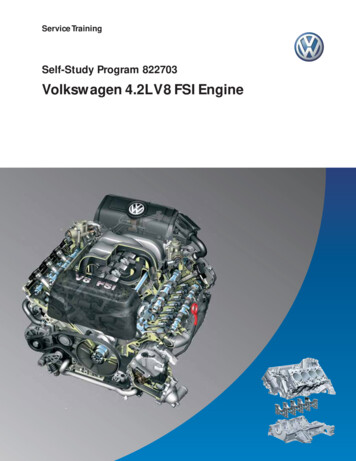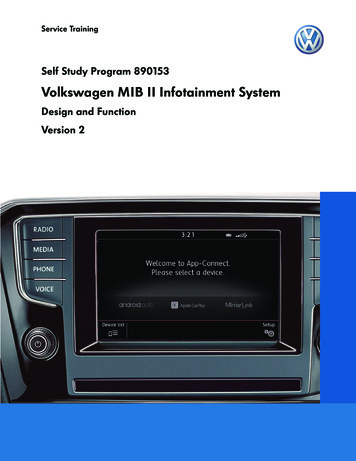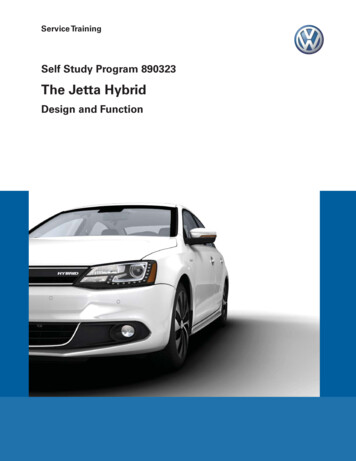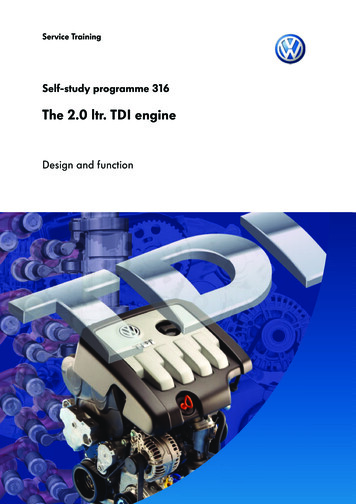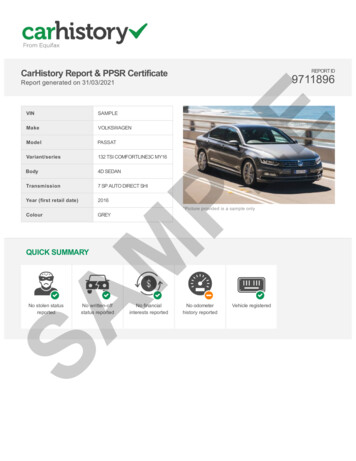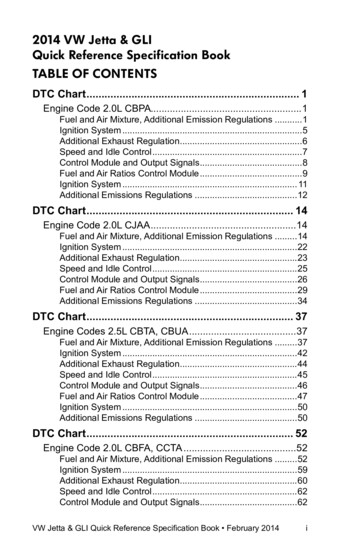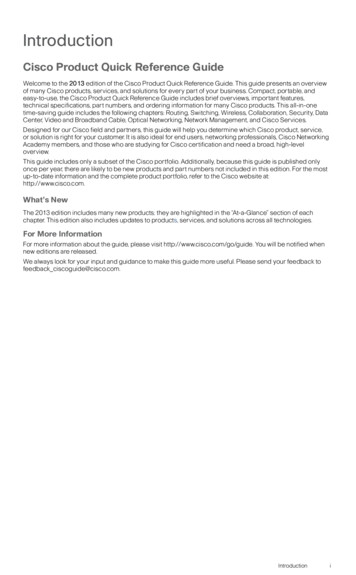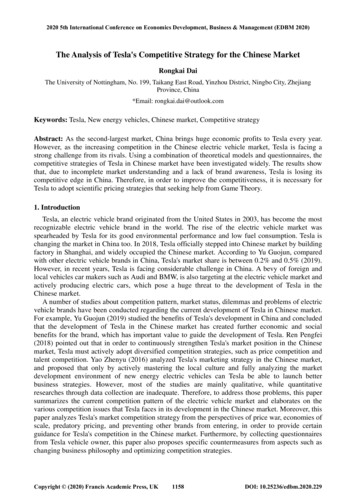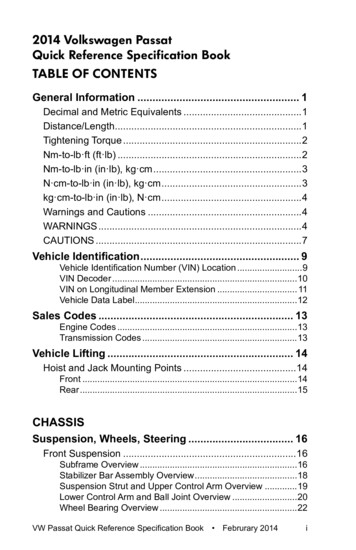
Transcription
2014 Volkswagen PassatQuick Reference Specification BookTable of ContentsGeneral Information. 1Decimal and Metric Equivalents.1Distance/Length.1Tightening Torque.2Nm-to-lb·ft (ft·lb).2Nm-to-lb·in (in·lb), kg·cm.3N·cm-to-lb·in (in·lb), kg·cm.3kg·cm-to-lb·in (in·lb), N·cm.4Warnings and Cautions.4WARNINGS.4CAUTIONS.7Vehicle Identification. 9Vehicle Identification Number (VIN) Location.9VIN Decoder.10VIN on Longitudinal Member Extension. 11Vehicle Data Label.12Sales Codes. 13Engine Codes.13Transmission Codes.13Vehicle Lifting. 14Hoist and Jack Mounting Points.14Front.14Rear.15CHASSISSuspension, Wheels, Steering. 16Front Suspension.16Subframe Overview.16Stabilizer Bar Assembly Overview.18Suspension Strut and Upper Control Arm Overview.19Lower Control Arm and Ball Joint Overview.20Wheel Bearing Overview.22VW Passat Quick Reference Specification Book Februrary 2014i
Drive Axle Overview, CV Joint VL 100.24Drive Axle Overview, CV Joint VL 107.26Drive Axle Overview, Triple Roller Joint AAR2600i.28Fastener Tightening Specifications.29Rear Suspension.30Wheel Bearing Housing and Wheel Bearing UnitOverview.30Stabilizer Bar Overview.32Suspension Strut, Shock Absorber and Spring Overview.33Wheel Bearing Housing and Wheel Bearing UnitOverview.34Self-Leveling Suspension.36Rear Vehicle Level Sensor Overview.36Fastener Tightening Specification.37Wheel Alignment Data.38Wheel Alignment Specified Values.38Steering.39Steering Wheel Overview.39Steering Column Overview.40Steering Gear Electro-Mechanical Steering Gear withSubframe Overview.42Steering Gear Hydraulic Steering Gear with SubframeOverview.44Power Steering Pump.46Fastener Tightening Specifications.47Brake System. 48General, Technical Data.48Brake PR Number, Allocation.48Front Brakes.48Rear Brakes.48Brake Master Cylinder and Brake Booster.48Front Brakes.49Rear Brakes.50Anti-lock Brake System (ABS).52ABS Control Module and ABS Hydraulic Unit Overview.52Front ABS Wheel Speed Sensor Overview.54Rear ABS Wheel Speed Sensor Overview.55Steering Angle Sensor -G85- Overview, Vehicles withoutElectromechanical Power Steering.56Mechanical Components.58Front Brakes Overview.58Rear Brakes Overview.60iiVW Passat Quick Reference Specification Book Februrary 2014
Parking Brake Overview.62Brake Pedal Overview.63Fastener Tightening Specifications.64Hydraulic Components.65Front Brake Caliper Overview.65Rear Brake Caliper Overview.66Body. 67Air Gap Body Dimensions.67Body, Front.67Body, Center.68Body, Rear.69Body Exterior.70Body Front.70Lock Carrier Assembly Overview.70Fender Assembly Overview.72Bulkhead Assembly Overview.73Hood, Lids.74Hood Release Lever and Bracket Assembly Overview.74Rear Lid Hinge Assembly Overview.75Rear Lid Latch Assembly Overview.76License Plate Holder Assembly Overview.77Fuel Filler Door Unit Assembly Overview.78Hood Striker Pin Assembly Overview.79Hood Hinges.80Hood Latch.81Rear Lid.82Rear Lid Hinges.83Rear Lid Latch.84Rear Lid Latch Striker.85Front Doors, Central Locking System.86Installation Components Assembly Overview.86Door Handle and Door Lock Assembly Overview.88Rear Doors.90Door Assembly Overview.90Rear Door Components Assembly Overview.92Door Handle and Door Lock Assembly Overview.94Sunroof.96Sunroof Assembly Overview.96Bumpers.98Front Bumper Assembly Overview.98Front Bumper Assembly Overview.99VW Passat Quick Reference Specification Book Februrary 2014iii
Front Bumper Cover Guides Assembly Overview.100Front Bumper Side Guide Assembly Overview.101Rear Bumper Assembly Overview.102Rear Bumper Cover Guides Assembly Overview.103Rear Bumper Carrier Assembly Overview.104Glass, Window Regulators.105Front Door Window Assembly Overview.105Rear Door Window Assembly Overview.106Exterior Equipment.107Diesel Engine Noise Insulation Assembly Overview.107Gasoline Engine Noise Insulation Assembly Overview.108Underbody Panels Assembly Overview.109Exterior Rearview Mirror Assembly Overview. 110Wheel Housing Liner Assembly Overview. 111Rear Wheel Housing Liner Assembly Overview. 112Body Interior.113Interior Equipment.113Storage Compartments, Covers and Trim TighteningSpecifications. 113Passenger Protection, Airbags, Seat Belts. 114Front Three-Point Seat Belt, Vehicles without Belt EndFitting Assembly Overview. 114Front Three-Point Seat Belt, Vehicles with Belt EndFitting Assembly Overview. 115Passenger Occupant Detection System ComponentLocation Overview. 116Passenger Protection Fastener Tightening Specifications. 117Interior Trim.118Instrument Panel Central Tube Assembly Overview. 118Interior Trim Fastener Tightening Specifications. 119Seat Frames Fastener Tightening Specifications. 119Heating, Ventilation and Air Conditioning. 120General, Technical Data.120Refrigerant Oil Distribution.120Refrigerant R134a Vapor Pressure Table.121Air Conditioning.122Condenser Overview.122Refrigerant Circuit Overview.123Fastener Tightening Specifications.124Electrical System. 125Communication Equipment.125ivVW Passat Quick Reference Specification Book Februrary 2014
Electrical Equipment.126Battery, Starter, Generator, Cruise Control.126Battery in Engine Compartment Overview.1263.6L Battery in Engine Compartment Overview.1273.6L External Starting Point with Suppressor -C24Overview.1281.8L Generator Overview.1292.5L Generator Overview.1303.6L Generator Overview.131TDI Generator Overview.132Starter Overview.133Manual Transmission 0A4 Starter Overview.134Automatic Transmission 09G Starter Overview.135Manual Transmission 02Q Starter Overview.136DSG Transmission Starter Overview.137Pyrotechnic Battery Isolator Overview.138Fastener Tightening Specifications.138Windshield Wiper/Washer Tightening Specifications.139Exterior Lights, Switches.140Fog Lamps Overview.140Halogen Headlamps Overview.142Rear Lid Tail Lamps Overview.144Side Panel Tail Lamps Overview.145Steering Column Switch, with KESSY Overview.146Steering Column Switch, without KESSY Overview.147Inter Lights, Switches Tightening Specifications.147Wiring Tightening Specification.148VW Passat Quick Reference Specification Book Februrary 2014vGeneralInformationFastener Tightening Specifications.125
GeneralInformationGeneral InformationDecimal and Metric EquivalentsDistance/LengthTo calculate: mm x 0.03937 9.010.020.030.040.050.060.070.080.090.0100.0VW Passat Quick Reference Specification Book 6789102030405060708090100Februrary 91.181.571.972.362.763.153.543.941
Tightening TorqueNm-to-lb·ft (ft·lb)To calculate: Nm x 0.738 9207214221229236243251258266273280288295VW Passat Quick Reference Specification Book Februrary 2014
Nm-to-lb·in (in·lb), 49459469479489500510GeneralInformationTo calculate: Nm x 8·85 lb·in Nm x 10.20 kg·cmN·cm-to-lb·in (in·lb), kg·cmTo calculate: N·cm x 0.089 lb·in N·cm x 0.102 6717682879297102VW Passat Quick Reference Specification Book Februrary 20143
kg·cm-to-lb·in (in·lb), N·cmTo calculate: kg·cm x 0.868 lb·in kg·cm x 9.81 s and CautionsWARNINGS Some repairs may be beyond your capability. If you lack the skills,tools and equipment, or a suitable workplace for any proceduredescribed in this manual, we suggest you leave such repairs to anauthorized dealer service department or other qualified shop. Do not reuse any fasteners that have become worn or deformedduring normal use. Many fasteners are designed to be used onlyonce and become unreliable and may fail when used a secondtime. This includes, but is not limited to, nuts, bolts, washers, selflocking nuts or bolts, circlips and cotter pins. Always replace thesefasteners with new parts. Never work under a lifted car unless it is solidly supported onstands designed for the purpose. Do not support a car on cinderblocks, hollow tiles or other props that may crumble undercontinuous load. Never work under a car that is supported solelyby a jack. Never work under the car while the engine is running. If you are going to work under a car on the ground, make surethe ground is level. Block the wheels to keep the car from rolling.Disconnect the battery negative (-) terminal (ground strap) toprevent others from starting the car while you are under it.4VW Passat Quick Reference Specification Book Februrary 2014
Remove rings, bracelets and other jewelry so they cannot causeelectrical shorts, get caught in running machinery, or be crushed byheavy parts. Tie back long hair. Do not wear a necktie, a scarf, loose clothing,or a necklace when you work near machine tools or runningengines. If your hair, clothing, or jewelry were to get caught in themachinery, severe injury could result. Do not attempt to work on your car if you do not feel well. Youincrease the danger of injury to yourself and others if you are tired,upset, or have taken medication or any other substance that maykeep you from being fully alert. Illuminate your work area adequately but safely. Use a portablesafety light for working inside or under the car. Make sure the bulbis enclosed by a wire cage. The hot filament of an accidentallybroken bulb can ignite spilled fuel, vapors or oil. Use a suitable container to catch draining fuel, oil, or brakefluid. Do not use food or beverage containers that might misleadsomeone into drinking from them. Store flammable fluids awayfrom fire hazards. Wipe up spills at once, but do not store oily ragswhich can ignite and burn spontaneously. Always observe good workshop practices. Wear goggles when youoperate machine tools or work with battery acid. Wear gloves orother protective clothing whenever the job requires working withharmful substances. Greases, lubricants and other automotive chemicals contain toxicsubstances, many of which are absorbed directly through the skin.Read the manufacturer’s instructions and warnings carefully. Usehand and eye protection. Avoid direct skin contact Disconnect the battery negative (-) terminal (ground strap)whenever you work on the fuel or electrical system. Do not smokeor work near heaters or other fire hazards. Keep an approved fireextinguisher handy. Friction materials (such as brake pads or shoes or clutch discs)contain asbestos fibers or other friction materials. Do not createdust by grinding, sanding, or cleaning with compressed air. Avoidbreathing dust. Breathing any friction material dust can lead toserious diseases and may result in death.(WARNINGS cont’d on next page)VW Passat Quick Reference Specification Book Februrary 20145GeneralInformation Never run the engine unless the work area is well ventilated.Carbon monoxide kills.
WARNINGS (cont’d) Batteries give off explosive hydrogen gas during charging. Keepsparks, lighted matches and open flame away from the top of thebattery. If hydrogen gas escaping from the cap vents is ignited, itignites the gas trapped in the cells and causes the batteryto explode. Connect and disconnect battery cables, jumper cables or a batterycharger only with the ignition off. Do not disconnect the batterywhile the engine is running. Do not quick-charge the battery (for boost starting) for longer thanone minute. Wait at least one minute before boosting the battery asecond time. Do not allow battery charging voltage to exceed 16.5 volts. Ifthe battery begins producing gas or boiling violently, reduce thecharging rate. Boosting a sulfated battery at a high charging ratecan cause an explosion. The A/C system is filled with chemical refrigerant, which ishazardous. The A/C system should be serviced only by trainedtechnicians using approved refrigerant recovery/recyclingequipment, trained in related safety precautions, and familiar withregulations governing the discharging and disposal of automotivechemical refrigerants. Do not expose any part of the A/C system to high temperaturessuch as open flame. Excessive heat increases system pressureand may cause the system to burst. Some aerosol tire inflators are highly flammable. Be extremelycautious when repairing a tire that may have been inflated using anaerosol tire inflator. Keep sparks, open flame or other sources ofignition away from the tire repair area. Inflate and deflate the tire atleast four times before breaking the bead from the rim. Completelyremove the tire from the rim before attemptingany repair. Some cars are equipped with a Supplemental Restraint System(SRS) that automatically deploys airbags and pyrotechnic seatbelt tensioners in the event of a frontal or side impact. Theseare explosive devices. Handled improperly or without adequatesafeguards, they can be accidentally activated and cause seriousinjury. The ignition system produces high voltages that can be fatal.Avoid contact with exposed terminals and use extreme care whenworking on a car with the engine running or the ignition on.6VW Passat Quick Reference Specification Book Februrary 2014
GeneralInformation Place jack stands only at locations specified by manufacturer.The vehicle lifting jack supplied with the vehicle is intended for tirechanges only. Use a heavy duty floor jack to lift the vehicle beforeinstalling jack stands. Battery acid (electrolyte) can cause severe burns. Flush contactarea with water, seek medical attention. Aerosol cleaners and solvents may contain hazardous or deadlyvapors and are highly flammable. Use only in a well ventilatedarea. Do not use on hot surfaces (such as engines or brakes). Do not remove coolant reservoir or radiator cap with the enginehot. Burns and engine damage may occur.CAUTIONS If you lack the skills, tools and equipment, or a suitable workshopfor any procedure described in this manual, we suggest you leavesuch repairs to an authorized dealer or otherqualified shop. Before starting a job, make certain that you have all the necessarytools and parts on hand. Read all the instructions thoroughlyand do not attempt shortcuts. Use tools appropriate to the workand use only replacement parts meeting original specifications.Makeshift tools, parts and procedures will not make good repairs. Use pneumatic and electric tools only to loosen threaded parts andfasteners. Never use these tools to tighten fasteners, especially onlight alloy parts. Always use a torque wrench to tighten fasteners tothe tightening torque specification listed. Be mindful of the environment and ecology. Before you drain thecrankcase, find out the proper way to dispose of the oil. Do notpour oil onto the ground, down a drain, or into a stream, pond orlake. Dispose of in accordance with Federal, State andLocal laws. The control module for the Anti-lock Brake System (ABS) cannotwithstand temperatures from a paint-drying booth or a heatlamp in excess of 95 C (203 F) and should not be subjected totemperatures exceeding 85 C (185 F) for more than two hours. Before doing any electrical welding on cars equipped with ABS,disconnect the battery negative (-) terminal (ground strap) and theABS control module connector. Always make sure the ignition is off before disconnecting battery.(CAUTIONS cont’d on next page)VW Passat Quick Reference Specification Book Februrary 20147
CAUTIONS (cont’d) Label battery cables before disconnecting. On some models,battery cables are not color coded. Disconnecting the battery may erase fault code(s) stored in controlmodule memory. Check for fault codes prior to disconnecting thebattery cables. If a normal or rapid charger is used to charge the battery,disconnect the battery and remove it from the vehicle to avoiddamaging paint and upholstery. Do not quick-charge the battery (for boost starting) for longer thanone minute. Wait at least one minute before boosting the battery asecond time. Connect and disconnect a battery charger only with the batterycharger switched off. Sealed or “maintenance free” batteries should be slow-chargedonly, at an amperage rate that is approximately 10% of thebattery’s ampere-hour (Ah) rating. Do not allow battery charging voltage to exceed 16.5 volts. Ifthe battery begins producing gas or boiling violently, reduce thecharging rate. Boosting a sulfated battery at a high charging ratecan cause an explosion.8VW Passat Quick Reference Specification Book Februrary 2014
Vehicle IdentificationVehicleIdentificationVehicle Identification Number (VIN) LocationThe VIN (Æ) is on the left side of the vehicle in the area ofthe windshield wiper mount. It is visible from the outside.VW Passat Quick Reference Specification Book Februrary 20149
VIN DecoderEnginerestraint system3G4C5V639810 11 12 13 14 15 16 17E W 5 3 2 0 1 48X2014See backWVW Europe Pass. Car1VW USA - Pass.Car3VW Mexico Pass. CarWVG Europe S.U.V.7AAssembly plantSeries2Vmodel yearVehicle type1WC Chattanooga P MoselD BratislavaV PortugalE EmdenW Wolfsburgm Mexico** SULEV II Super Low Emissions Vehicle*** 7 position US model characters arealphabetic beginning with 2010 MY. ROWmodel characters, where different, are listed inparenthesis (), for reference only.**** Jetta and Jetta SportWagen models areidentified by WMI code of 3VW. GtI and Golfmodels are identified by WMI code of WVW.9 Check digit10 model year11 Assembly plant1314151617VW Passat Quick Reference Specification BookH 5 cyl 2.5L 170hp (CBTA-M) PassatK 4 cyl 2.0L 115hp (CBPA) JettaL 4 cyl 2.0L TDI 140hp (CJAA) Beetle, BeetleConvertible, Jetta, Jetta SportWagenm 4 cyl 2.0L TDI 140hp (CJAA) Golfm VR6 3.6L 280hp (CDVB) Passatn 4 cyl 2.0L 200hp (CCTA) CCn 4 cyl 2.0L TDI 140hp (CKRA) PassatP 4 cyl 2.0L 200hp (CBFA-PZEV*) CCP 5 cyl 2.5L 170hp (CBUA-M-PZEV*)Beetle, Beetle Convertible, Jetta, JettaSportWagen, PassatP V6 3.0L TDI 240hp (CNRB) TouaregS 4 cyl 1.8L 170hp (CPKA) PassatS 4 cyl 2.0L 210hp (CPLA) Beetle, BeetleConvertible, Jetta GLIt 4 cyl 1.8L 170hp (CPRA-PZEV*) Passatt 4 cyl 2.0L 210hp (CPPA-PZEV*) Beetle,Beetle Convertible, Jetta GLIU VR6 3.6L 280hp (CNNA) CCV 4 cyl 2.0L 200hp (CCTA) TiguanW 4 cyl 2.0L 200hp (CBFA-SULEV II**) EosX 5 cyl 2.5L 170hp (CBTA-M) Beetle, BeetleConvertible, Jetta, Jetta SportWagen0 4 cyl 1.8L 170hp (CPKA) Beetle, BeetleConvertible, Jetta1 4 cyl 1.8L 170hp (CPRA-PZEV*) Beetle, BeetleConvertible, Jetta3 4 cyl 1.4L 150hp 28 Kw (CNLA-PZEV*)Jetta Hybrid12Sequentialproduction number(position 12 - 17)SequentialProductNumberA3*** PassatAH (1f) EosAJ (16/1K)**** Golf,GTI, Jetta,JettaSportWagen CC Beetle, BeetleConv. Tiguan Touareg8 (position 7 & 8)An (3C)At7 modelAX (5n)BP (7P)6 restraint systemC Chattanooga P MoselD BratislavaV PortugalE EmdenW Wolfsburgm MexicoCalculate perNHTSA Code171615141311 Assembly plant9 Check digit10 model year7 model8 (position 7 & 8)SequentialProductNumber2014 restraint System:M 1991N 1992P 1993R 1994S 1995T 1996V 1997W 1998X 1999Y 20001 20012 20023 20034 20045 20056 20067 20078 20089 2009A 2010B 2011C 2012D 2013E 20145 EnginePass. CarWVG Europe S.U.V.4 Series* PZEV Partial Zero Emissions Vehicle3 Vehicle type** SULEV II Super Low Emissions Vehicle2 manufacturerM 1991N 1992P 1993R 1994S 1995T 1996V 1997W 1998X 1999Y 20001 20012 20023 20034 20045 20056 20067 20078 20089 2009A 2010B 2011C 2012D 2013E 2014*** 7 position US model characters arealphabetic beginning with 2010 MY. ROWmodel characters, where different, are listed inparenthesis (), for reference only.1 Country of origin**** Jetta and Jetta SportWagen
General Information VW Passat Quick Reference Specification Book Februrary 2014 1 GEnErAL InformAtIon Decimal and Metric Equivalents Distance/Length
